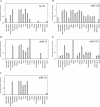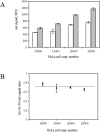Quantitation of microRNAs using a modified Invader assay
- PMID: 15208450
- PMCID: PMC1370605
- DOI: 10.1261/rna.5250604
Quantitation of microRNAs using a modified Invader assay
Abstract
The short lengths of microRNAs (miRNAs) present a significant challenge for detection and quantitation using conventional methods for RNA analysis. To address this problem, we developed a quantitative, sensitive, and rapid miRNA assay based on our previously described messenger RNA Invader assay. This assay was used successfully in the analysis of several miRNAs, using as little as 50-100 ng of total cellular RNA or as few as 1,000 lysed cells. Its specificity allowed for discrimination between miRNAs differing by a single nucleotide, and between precursor and mature miRNAs. The Invader miRNA assay, which can be performed in unfractionated detergent lysates, uses fluorescence detection in microtiter plates and requires only 2-3 h incubation time, allowing for parallel analysis of multiple samples in high-throughput screening analyses.
Figures





References
-
- Banerjee, D. and Slack, F. 2002. Control of developmental timing by small temporal RNAs: A paradigm for RNA-mediated regulation of gene expression. Bioessays 24: 119–129. - PubMed
-
- Bartel, D.P. 2004. MicroRNAs: Genomics, biogenesis, mechanism, and function. Cell 116: 281–297. - PubMed
-
- Bevington, P.R. 1969. Propagation of errors. In Data reduction and error analysis for the physical sciences, pp. 56–60. McGraw-Hill Book Company, New York.
-
- Cantor, C.R., Warshaw, M.M., and Shapiro, H. 1970. Oligonucleotide interactions. III. Circular dichroism studies of the conformation of deoxyoligonucleotides. Biopolymers 9: 1059–1077. - PubMed
-
- Carmell, M.A., Xuan, Z., Zhang, M.Q., and Hannon, G.J. 2002. The Argonaute family: Tentacles that reach into RNAi, developmental control, stem cell maintenance, and tumorigenesis. Genes & Dev. 16: 2733–2742. - PubMed
Publication types
MeSH terms
Substances
Grants and funding
LinkOut - more resources
Full Text Sources
Other Literature Sources
Molecular Biology Databases
